Physical and Mechanical Properties and Constitutive Model of Rock Mass Under THMC Coupling: A Comprehensive Review
Abstract
1. Introduction
2. Physical and Mechanical Properties of Rock Mass Under THMC Coupling
2.1. Overview of Multi-Field Coupled Rock-Deformation Studies
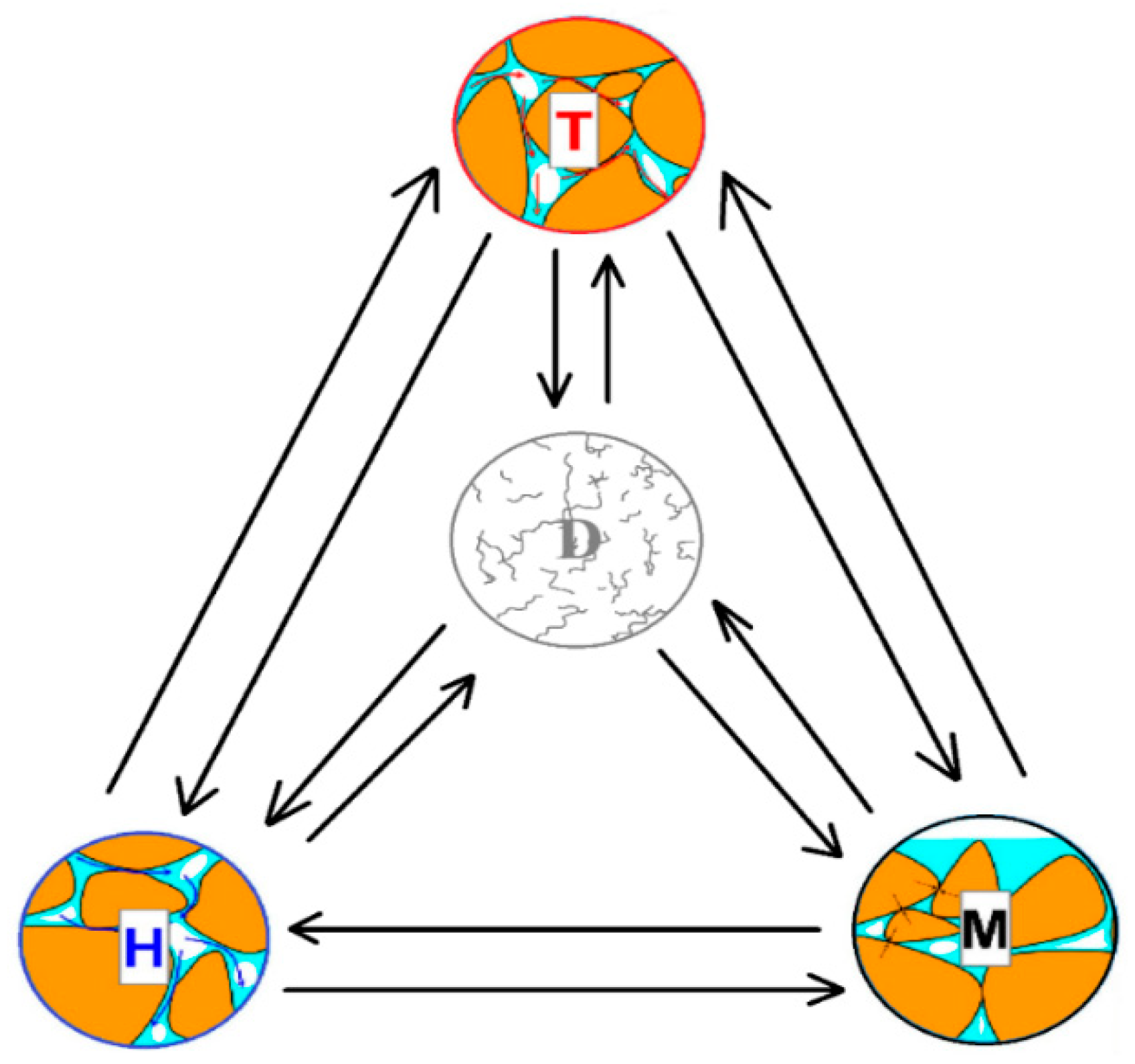
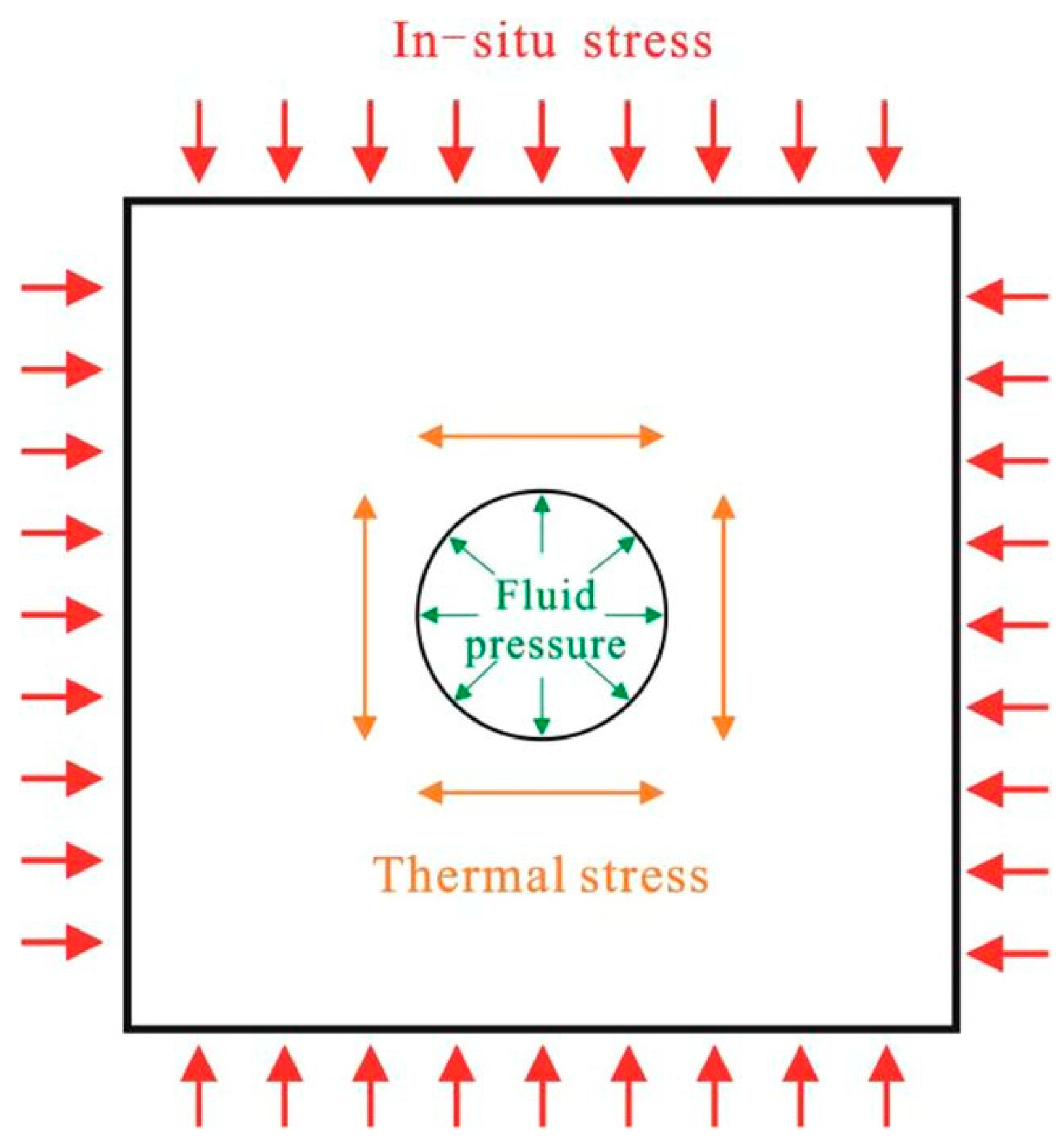
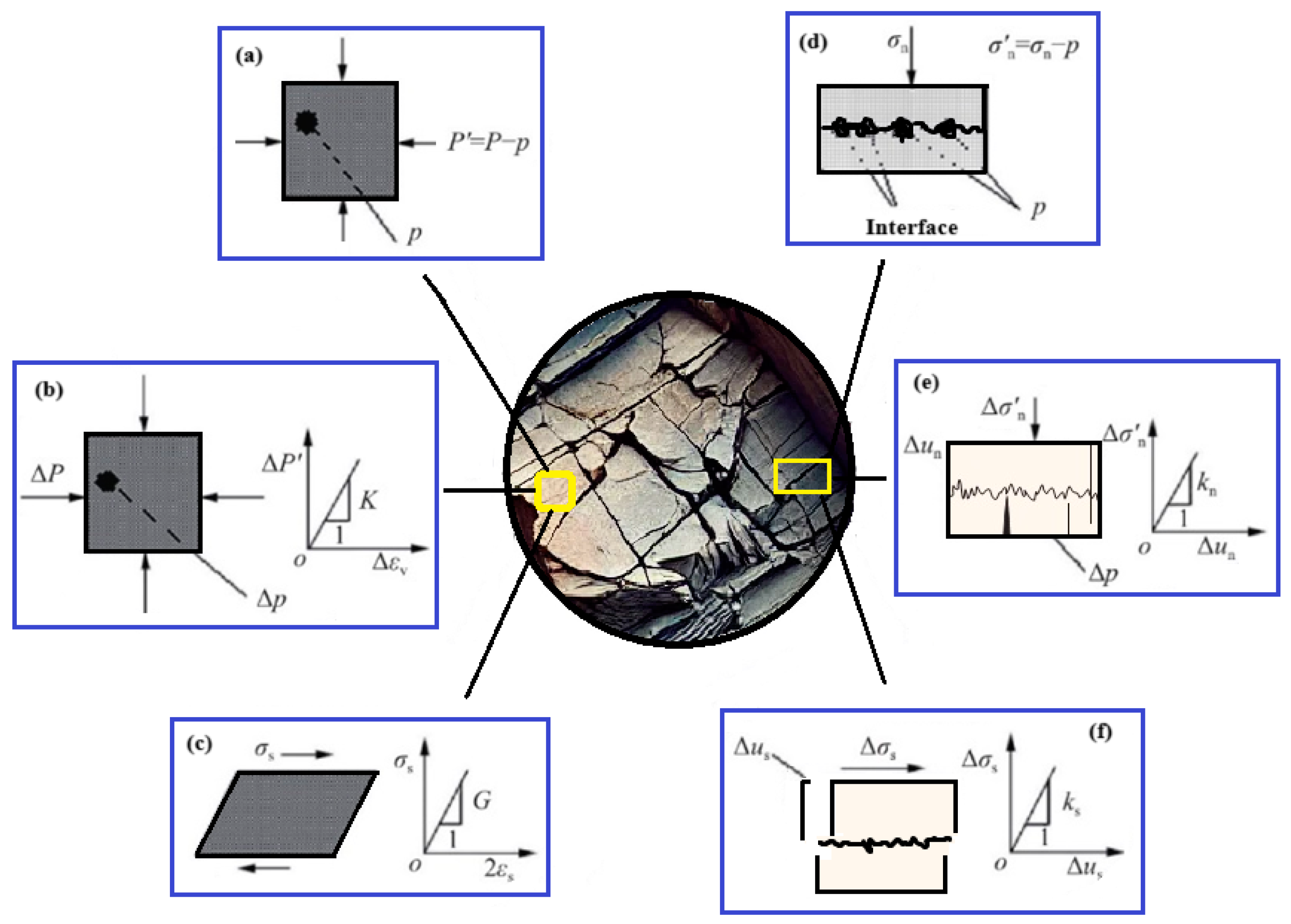
2.2. THMC Coupling Test of Deep Rocks
2.3. Theoretical Study of Multi-Field Coupling Mechanics in Rocks
2.3.1. Rock Strength and Failure Mechanisms
2.3.2. Advancements in Fracture Mechanics
2.3.3. Current Research Directions
3. Constitutive Model of Rock Mass Under THMC Coupling
3.1. Constitutive Model Under THMC Coupling with Governing Equations
3.1.1. Mechanical Behavior (M)
3.1.2. Hydraulic Behavior (H)
3.1.3. Thermal Behavior (T)
3.1.4. Chemical Behavior (C)
3.1.5. Coupling Effects in THMC
Full THMC-Coupled Governing Equations
- Mechanical equilibrium equation:where is the stress tensor, is density, and is the gravitational acceleration in Equation (12).
- Heat conduction and convection equation:
- Darcy’s Law for fluid flow:where is the specific storage in Equation (14).
- Reactive transport equation:
3.2. Multi-Field Coupled Constitutive Model of Rocks
3.2.1. Multi-Field Coupled Constitutive Model
THM Coupling Models
3.2.2. Evolution of Permeability and Chemical Reactions
Flow–Chemical Coupling Models
Pressure Dissolution and Permeability Evolution
3.2.3. Influence of Multi-Field Coupling on Rock Damage
Challenges and Future Directions
Multi-Field Coupling for Geomechanical Applications
Numerical Simulations and Constitutive Models
3.2.4. Creep Constitutive Model Study of Deep Rocks
Water Content and Rock Creep
Temperature and Time-Dependent Deformation
Key Rheological Models
- I.
- Empirical constitutive models
- II.
- Component combination models
- III.
- Rheological models in the form of integrals
- IV.
- Damage rheological models
4. Conclusions and Prospects
- I.
- Mathematical models and analytical methods for multi-scale coupling:
- II.
- Comprehensive study of the fully coupled THMC processes:
- III.
- Intelligent systems for multi-field coupling:
- IV.
- Multidisciplinary and interdisciplinary integration:
Author Contributions
Funding
Institutional Review Board Statement
Informed Consent Statement
Data Availability Statement
Acknowledgments
Conflicts of Interest
References
- Jing, L.; Tsang, C.F.; Stephansson, O. DECOVALEX—An international co-operative research project on mathematical models of coupled THM processes for safety analysis of radioactive waste repositories. Int. J. Rock Mech. Min. Sci. Geomech. Abstr. 1995, 32, 389–398. [Google Scholar] [CrossRef]
- Birkholzer, J.T.; Bond, A. DECOVALEX-2019—An international collaboration for advancing the understanding and modeling of coupled Thermo-Hydro-Mechanical-Chemical (THMC) processes in geological systems. Int. J. Rock Mech. Min. Sci. 2022, 154, 105097. [Google Scholar] [CrossRef]
- Birkholzer, J.T.; Tsang, C.F.; Bond, A.E.; Hudson, J.A.; Jing, L.; Stephansson, O. Twenty-five yeahrs of DECOVALEX—Scientific advances and lessons learned from an international research collaboration in coupled subsurface processes, Invited Review Paper. Int. J. Rock. Mech. Min. Sci. 2019, 122, 103995. [Google Scholar] [CrossRef]
- Hudson, J.A.; Tsang, C.F.; Jing, L. Coupled THMC modeling for safety assessment of geological disposal of radioactive wastes: The DECOVALEX project (1992–2015). In Rock Mechanics and Engineering; Feng, X.-T., Ed.; CRC Press: London, UK, 2017; Volume 3, pp. 15–56. [Google Scholar]
- Tsang, C.F.; Stephansson, O.; Jing, L.; Kautsky, F. DECOVALEX Project: From 1992 to 2007. J. Environ. Geol. 2009, 57, 1221–1238. [Google Scholar] [CrossRef]
- Stephansson, O.; Jing, L.; Tsang, C.F. (Eds.) Coupled Thermo-Hydromechanical Processes of Fractured Media―Mathematical and Experimental Studies; Elsevier: Amsterdam, The Netherlands, 1996; Volume 79, p. 575. [Google Scholar]
- Tsang, C.F. Coupled Processes Associated with Nuclear Waste Repositories; Tsang, C.F., Ed.; Academic Press: San Diego, CA, USA, 1987. [Google Scholar]
- Tsang, C.F. Coupled thermomechanical hydrochemical processes in rock fractures. Rev. Geophys. 1991, 29, 537–551. [Google Scholar] [CrossRef]
- Piotr, M.; Niedbalski, Z. A comprehensive geomechanical method for the assessment of rockburst hazards in underground mining. Int. J. Min. Sci. Technol. 2020, 30, 345–355. [Google Scholar]
- Delage, P.; Cui, Y.J.; Tang, M. Clays in radioactive waste disposal. J. Rock. Mech. Geotech. Eng. 2010, 2, 111–123. [Google Scholar] [CrossRef]
- Gens, A.; Olivella, S. Clay barrier in radioactive waste disposal. Rev. Française Génie Civ. 2001, 5, 845–856. [Google Scholar] [CrossRef]
- Hueckel, T.; Peano, A. Some geotechnical aspects of radioactive waste isolation in continental clays. Comput. Geotech. 1987, 3, 157–182. [Google Scholar] [CrossRef]
- Laloui, L.; Modaressi, H. Modelling of the thermo-hydroplastic behavior of clays. In Hydromechanical and Thermo-Hydro-Mechanical Behavior of Deep Argillaceous Rock; Hoteit, N., Ed.; Balkema: Amsterdam, The Netherlands, 2002; pp. 161–170. [Google Scholar]
- Zheng, L.; Rutqvist, J.; Xu, H.; Birkholzer, J.T. Coupled THMC models for bentonite in an argillite repository for nuclear waste: Illitization and its effect on swelling stress under high temperature. Eng. Geol. 2017, 30, 118–129. [Google Scholar] [CrossRef]
- Burger, A.; Recordon, E.; Bovet, D.; Cotton, L.; Saugy, B. Thermique des Nappes Souterraines; Presse Polytechniques Universitaires Romandes: Lausanne, Switzerland, 1985. [Google Scholar]
- Dupray, F.; Laloui, L.; Kazangba, A. Numerical analysis of seasonal heat storage in an energy pile foundation. Comput. Geotech. 2014, 55, 67–77. [Google Scholar] [CrossRef]
- Laloui, L.; Nuth, M.; Vulliet, L. Experimental and numerical investigations of the behavior of heat exchanged pile. Int. J. Numer. Anal. Meth Geomech. 2006, 30, 763–781. [Google Scholar] [CrossRef]
- Yui, M. A research program for numerical experiments on coupled thermo-hydro-mechanical and chemical processes. Nature 2002, 300, 747–750. [Google Scholar]
- Ito, A.; Yum, M.; Sugita, Y.; Kawakami, S. A research program for numerical experiments on the coupled thermo-hydro-mechanical and chemical processes in the near-field of a high-level radioactive waste repository. Elsevier Geo-Eng. Book Ser. 2004, 2, 353–358. [Google Scholar]
- Mitchell, J.K.; McMillan, J.C.; Green, S.L.; Sisson, R.C. Field testing of cable backfill systems. In Underground Cable Backfill; Pergamon Press: New York, NY, USA, 1982; pp. 19–33. [Google Scholar]
- Baldi, G.; Hueckel, T.; Pellegrini, R. Thermal volume changes on the mineral-water system in low porosity clay soils. Can. Geotech. J. 1988, 25, 807–825. [Google Scholar] [CrossRef]
- Francois, B.; Laloui, L.; Laurent, C. Thermo-hydro-mechanical simulation of ATLAS in situ large scale test in Boom clay. Comput. Geotech. 2009, 36, 626–640. [Google Scholar] [CrossRef]
- Hueckel, T.; Baldi, G. Thermoplasticity of saturated clays: Experimental constitutive study. J. Geotech. Eng-ASCE 1990, 116, 1778–1796. [Google Scholar] [CrossRef]
- Sultan, N.; Delage, P.; Cui, Y.J. Temperature effects on the volume changes behavior of Boom clay. Eng. Geol. 2002, 64, 135–145. [Google Scholar] [CrossRef]
- Jobmann, M.; Polster, M. The response of Opalinus clay due to heating: A combined analysis of in situ measurements, laboratory investigations and numerical calculations. Phys. Chem. Earth 2007, 32, 929–936. [Google Scholar] [CrossRef]
- Tsang, C.F.; Barnichon, J.D.; Birkholzer, J.; Li, X.L.; Liu, H.H.; Sillen, X. Coupled thermo-hydro-mechanical processes in the near field of high-level radioactive waste repository in clay formations. Int. J. Rock. Mech. Min. Sci. 2012, 49, 31–44. [Google Scholar] [CrossRef]
- Zhang, C.L.; Rothfuchs, T.; Su, K.; Hoteit, N. Experimental study of the thermo-hydro-mechanical behavior of indurated clays. Phys. Chem. Earth 2007, 32, 957–965. [Google Scholar] [CrossRef]
- Gasc-Barbier, M.; Chanchole, S.; Be’rest, P. Creep behavior of Bure clayey rock. Appl. Clay Sci. 2004, 26, 449–458. [Google Scholar] [CrossRef]
- Koyama, T.; Chijimatsu, M.; Shimizu, H.; Nakama, S.; Fujita, T.; Kobayashi, A.; Ohnishi, Y. Numerical modeling for the coupled thermo-mechanical processes and spalling phenomena in Äspö Pillar Stability Experiment (APSE). J. Rock Mech. Geotech. Eng. 2013, 5, 58–72. [Google Scholar] [CrossRef]
- Pan, P.; Feng, X. Numerical study on coupled thermo-mechanical processes in Äspö Pillar Stability Experiment. J. Rock Mech. Geotech. Eng. 2013, 5, 136–144. [Google Scholar] [CrossRef]
- Heuze, F.E. High-temperature mechanical, physical and thermal properties of granitic rocks—A review. Int. J. Rock. Mech. Min. Sci. Geomech. Abstr. 1983, 20, 3–10. [Google Scholar] [CrossRef]
- Hicher, P.Y. Étude des Propriétés Mécaniques des Argiles à L’aide D’essais Triaxiaux, Influence de la Vitesse et de la Temperature; Report of the soil mechanics laboratory; École Centrale de Paris: Gif-sur-Yvette, France, 1974. [Google Scholar]
- Fan, C.; Luo, M.; Li, S.; Zhang, H.; Yang, Z.; Liu, Z. A Thermo-Hydro-Mechanical-Chemical Coupling Model and Its Application in Acid Fracturing Enhanced Coalbed Methane Recovery Simulation. Energies 2019, 12, 626. [Google Scholar] [CrossRef]
- Dwivedi, R.D.; Goel, R.K.; Pasad, V.V.R.; Sinha, A. Thermomechanical properties of Indian and other granites. Int. J. Rock. Mech. Min. Sci. 2008, 45, 303–315. [Google Scholar] [CrossRef]
- Lion, M.; Skoczylas, F.; Lede’sert, B. Effects of heating on the hydraulic and poroelastic properties of Bourgogne limestone. Int. J. Rock. Mech. Min. Sci. 2005, 42, 508–520. [Google Scholar] [CrossRef]
- Cekerevac, C.; Laloui, L. Experimental study of thermal effects on the mechanical behaviour of a clay. Int. J. Numer. Anal. Methods Geomech. 2004, 28, 209–228. [Google Scholar] [CrossRef]
- Homand-Etienne, F. Comportement Mécanique des Roches en Fonction de la Température. Ph.D. Thesis, Institute National Polytechnique de Lorraine, Nancy, France, 1985; 261p. [Google Scholar]
- Baldi, G.; Hueckel, T.; Peano, A.; Pellegrini, R. Developments in Modeling of Thermo-Hydro-Geomechanical Behavior of Boom Clay and Clay-Based Buffer Materials; A Report EUR 13365/1&2 EN; Commission of European Communities, Nuclear Science and Technology: Brussels, Belgium, 1990; Volume 1–2. [Google Scholar]
- Homand-E’tienne, F.; Houpert, R. Thermally induced microcracking in granites: Characterization and analysis. Int. J. Rock. Mech. Min. Sci. Geomech. Abstr. 1989, 26, 125–134. [Google Scholar] [CrossRef]
- Wong, T.F. Effects of temperature and pressure on failure and post-failure behavior of Westerly granite. Mech. Mater. 1982, 1, 3–17. [Google Scholar] [CrossRef]
- Fisher, G.J.; Paterson, M.S. Dilatancy during deformation at high temperatures and pressures. J. Geophys. Res. 1989, 94, 607–617. [Google Scholar] [CrossRef]
- Byerlee, J.D. Brittle–ductile transition in rocks. J. Geophys. Res. 1968, 73, 4741–4750. [Google Scholar] [CrossRef]
- Evans, B.; Fredrich, J.T.; Wong, T.F. The brittle-ductile transition in rocks: Recent experimental and theoretical progress. In The Brittle-Ductile Transition in Rocks; Duba, A.G., Durham, W.B., Handin, J.W., Wang, H.F., Eds.; American Geophysical Union: Washington, DC, USA, 2013; Volume 86, pp. 1–20. [Google Scholar] [CrossRef]
- Yi, W.; Rao, Q.H.; Li, Z.; Sun, D.L.; Shen, Q.Q. Thermo-hydro-mechanical-chemical (THMC) coupling fracture criterion of brittle rock. Trans. Nonferrous Met. Soc. China 2021, 31, 2835. [Google Scholar] [CrossRef]
- Park, C.H.; Bobet, A. Crack initiation, propagation and coalescence from frictional flaws in uniaxial compression. Eng. Fract. Mech. 2010, 77, 2727–2748. [Google Scholar] [CrossRef]
- Yu, S.F.; Wu, A.X.; Wang, Y.M. Insight into the structural evolution of porous and fractured media by forced aeration during heap leaching. Int. J. Min. Sci. Technol. 2018, 29, 803–807. [Google Scholar] [CrossRef]
- Bratov, V.; Krivtsov, A. Analysis of energy required for initiation of inclined crack under uniaxial compression and mixed loading. Eng. Fract. Mech. 2019, 216, 106518. [Google Scholar] [CrossRef]
- Prager, W. Non-isothermal plastic deformation. Bol. Koninkl Nedrl Akad. Wet. 1958, 8, 176–182. [Google Scholar]
- Zhu, C.; Arson, C. A thermo-mechanical damage model for rock stiffness during anisotropic crack opening and closure. Acta Geotech. 2014, 9, 847–867. [Google Scholar] [CrossRef]
- Schofield, A.N.; Wroth, C.P. Critical State Soil Mechanics; McGraw-Hill: London, UK, 1968. [Google Scholar]
- Dizier, A. Caractérisation des Effets de Température dans la Zone Endommagée Autour de Tunnels de Stockage de Déchets Nucléaires dans des Roches Argileuses. Ph.D. Thesis, Université de Liège, Liège, Belgium, 2011. Available online: https://orbi.uliege.be/handle/2268/98834 (accessed on 16 September 2011).
- Hueckel, T.; Peano, A.; Pellegrini, R. A constitutive law for thermoplastic behaviour of rocks: An analogy with clays. Surv. Geophys. 1994, 15, 643–671. [Google Scholar] [CrossRef]
- Hueckel, T.; Borsetto, M. Thermoplasticity of saturated soils and shales: Constitutive equations. J. Geotech. Eng. 1990, 116, 1765–1777. [Google Scholar] [CrossRef]
- Laloui, L.; Cekerevac, C. Thermo-plasticity of clays: An isotropic yield mechanism. Comput. Geotech. 2003, 30, 649–660. [Google Scholar] [CrossRef]
- Picard, J.M. Écrouissage Thermique des Argiles Saturées: Application au Stockage des Déchets Radioactifs. Ph.D. Thesis, Ecole Nationale des Ponts et Chaussées, Champs-sur-Marne, France, 1994. [Google Scholar]
- Ouyang, T.; Tamma, K.K. ON adaptive time stepping approaches for thermal solidification processes. Int. J. Numer. Meth Heat. Fluid. Flow. 1996, 6, 37–50. [Google Scholar] [CrossRef]
- Kolditz, O.S. Stoff-und Wärmetransport im Kluftgestein; Borntraeger Verl: Berlin/Stuttgart, Germany, 1997. [Google Scholar]
- Wang, W.; Gorke, U.J.; Kolditz, O. Adaptive time stepping with automatic control for modeling nonlinear H2M coupled processes in porous media. In Proceedings of the 45th US Rock Mechanics/Geomechanics Symposium, San Francisco, CA, USA, 26–29 June 2011. [Google Scholar]
- Wang, W.; Schnicke, T.; Kolditz, O. Parallel finite element method and time stepping control for non-isothermal poro-elastic problems. Comput. Mater. Contin. 2011, 21, 217–235. [Google Scholar]
- Bond, A.; Bruský, I.; Chittenden, N.; Feng, X.T.; Kolditz, O.; Lang, P.; Lu, R.; McDermott, C.; Neretnieks, I.; Pan, P.Z.; et al. Development of approaches for modelling coupled thermal-hydraulic-mechanical-chemical processes in single granite fracture experiments. Environ. Earth Sci. 2016, 75, 1313. [Google Scholar] [CrossRef]
- Bond, A.; Bruský, I.; Cao, T.; Chittenden, N.; Fedors, R.; Feng, X.T.; Gwo, J.P.; Kolditz, O.; Lang, P.; McDermott, C.; et al. A synthesis of approaches for modelling coupled thermal-hydraulic-mechanical-chemical processes in a single novaculite fracture experiment. Environ. Earth Sci. 2017, 76, 12. [Google Scholar] [CrossRef]
- McDermott, C.I.; Bond, A.; Harris, A.F.; Chittenden, N.; Thatcher, K. Application of hybrid numerical and analytical solutions for the simulation of coupled thermal, hydraulic, mechanical and chemical processes during fluid flow through a fractured rock. Environ. Earth Sci. 2015, 74, 7837. [Google Scholar] [CrossRef]
- Chittenden, N.; McDermott, C.I.; Bond, A.E.; Wilson, J.; Norris, S. Evaluating the importance of different coupled thermal, hydraulic, mechanical and chemical process simulations during fluid flow experiments in fractured novaculite and fractured granite. Environ. Earth Sci. 2016, 75, 1133. [Google Scholar] [CrossRef]
- Pan, P.Z.; Feng, X.T.; Zheng, H.; Bond, A. An approach for simulating the THMC process in single novaculite fracture using EPCA. Environ. Earth Sci. 2016, 75, 1150. [Google Scholar] [CrossRef]
- Lu, R.; Watanabe, N.; He, W.; Jang, E.; Shao, H.; Kolditz, O.; Shao, H. Calibration of water-granite interaction with pressure solution in a flow-through fracture under confining pressure. Environ. Earth Sci. 2017, 76, 417. [Google Scholar] [CrossRef]
- Tsang, C.F. Introductory editorial to the special issue on the DECOVALEX-THMC project. Environ. Geol. 2009, 57, 1217–1219. [Google Scholar] [CrossRef]
- Pan, P.Z.; Feng, X.T.; Huang, X.H. Coupled THM processes in EDZ of crystalline rocks using an elasto-plastic cellular automaton. Environ. Geol. 2009, 57, 1299–1311. [Google Scholar] [CrossRef]
- Jia, Y.; Bian, H.B.; Su, K.; Kondo, D.; Shao, J.F. Elastoplastic damage modeling of desaturation and resaturation in argillites. Int. J. Numer. Anal. Methods Geomech. 2010, 34, 187–220. [Google Scholar] [CrossRef]
- Souley, M.; Armand, G.; Su, K.; Ghoreychi, M. Modeling the viscoplastic and damage behavior in deep argillaceous rocks. Phys. Chem. Earth Parts A/B/C 2011, 36, 1949–1959. [Google Scholar] [CrossRef]
- Huang, Y.; Shen, W.Q.; Shao, J.F.; Abou-Chakra Guéry, A.; Jia, Y. Multi-scale modeling of time-dependent behavior of claystones with a viscoplastic compressible porous matrix. Mech. Mater. 2014, 79, 25–34. [Google Scholar] [CrossRef]
- Salehnia, F.; Collin, F.; Li, X.L.; Dizier, A.; Sillen, X.; Charlier, R. Coupled modeling of Excavation Damaged Zone in Boom clay: Strain localization in rock and distribution of contact pressure on the gallery’s lining. Comput. Geotech. 2015, 69, 396–410. [Google Scholar] [CrossRef]
- Gens, A.; Wieczorek, K.; Gaus, I.; Garitte, B.; Mayor, J.C.; Schuster, K.; Armand, G.; García-Siñeriz, J.L.; Trick, T. Performance of the Opalinus Clay under thermal loading: Experimental results from Mont Terri rock laboratory (Switzerland). Swiss J. Geosci. 2017, 110, 269–286. [Google Scholar] [CrossRef]
- Mánica, M.; Gens, A.; Vaunat, J.; Ruiz, D.F. A cross-anisotropic formulation for elastoplastic models. Géotech. Lett. 2016, 6, 156–162. [Google Scholar] [CrossRef]
- Mánica, M.; Gens, A.; Vaunat, J.; Ruiz, D.F. A time-dependent anisotropic model for argillaceous rocks. Application to an underground excavation in Callovo-Oxfordian claystone. Comput. Geotech. 2017, 85, 341–350. [Google Scholar] [CrossRef]
- Mánica, M.; Gens, A.; Vaunat, J.; Ruiz, D. Nonlocal plasticity modeling of strain localization in stiff clays. Comput. Geotech. 2018, 103, 138–150. [Google Scholar] [CrossRef]
- Mánica, M.; Gens, A.; Ovando-Shelley, E.; Botero, E.; Vaunat, J. An effective combined framework for modeling the time-dependent behavior of soft structured clays. Acta Geotech. 2021, 16, 535–550. [Google Scholar] [CrossRef]
- Mánica, M.; Gens, A.; Vaunat, J.; Armand, G.; Vu, M. Numerical simulation of underground excavations in an indurated clay using non-local regularisation. Part 1: Formulation and base case. Géotechnique 2022, 72, 1092–1112. [Google Scholar] [CrossRef]
- Zhang, N.; Luo, Z.; Zhao, L.; Zhu, R.; Chen, W.; Liu, G.; Chen, X.; Xie, Y.; Cheng, L. Innovative thermo-responsive in-situ generated proppant: Laboratory tests and field application. J. Petrol. Sci. Eng. 2022, 208, 109514. [Google Scholar] [CrossRef]
- Bernier, F.; Lemy, F.; De Canniere, P.; Detilleux, V. Implications of safety requirements for the treatment of THMC processes in geological disposal systems for radioactive waste. J. Rock. Mech. Geotech. Eng. 2017, 9, 428–434. [Google Scholar] [CrossRef]
- Fan, C.; Elsworth, D.; Li, S.; Zhou, L.; Yang, Z.; Song, Y. Thermo-hydro-mechanical-chemical couplings controlling CH4 production and CO2 sequestration in enhanced coalbed methane recovery. Energy 2019, 173, 1054–1077. [Google Scholar] [CrossRef]
- Tao, M.; Pei, J.; Gan, F.; Hu, Y.; Zhang, Z.; Zhang, D. Permeability and porosity in damaged salt interlayers under coupled THMC conditions. J. Petrol. Sci. Eng. 2022, 211, 110218. [Google Scholar]
- Zhang, R.; Winterfeld, P.H.; Yin, X.; Xiong, Y.; Wu, Y.S. Sequentially coupled THMC model for CO2 geological sequestration into a 2D heterogeneous saline aquifer. J. Nat. Gas. Sci. Eng. 2015, 27, 579–615. [Google Scholar] [CrossRef]
- Luo, Z.; Cheng, L.; Zhao, L.; Xie, Y. Study on the mechanism of reactive acid transport in fractured two-mineral carbonate rocks. J. Nat. Gas. Sci. Eng. 2021, 94, 104118. [Google Scholar] [CrossRef]
- Yi, W.; Rao, Q.H.; Li, Z.; Shen, Q.Q. A new measurement method of crack propagation rate for brittle rock under THMC coupling condition. Trans. Nonferrous Met. Soc. China 2019, 129, 1728–1736. [Google Scholar] [CrossRef]
- Zhu, J.; Yi, L.; Yang, Z.; Duan, M. Three-dimensional numerical simulation on the thermal response of oil shale subjected to microwave heating. Chem. Eng. J. 2021, 407, 127197. [Google Scholar] [CrossRef]
- Wu, L.; Luo, Z.; Zhao, L.; Zhang, N.; Yao, Z.; Jia, Y. Transient temperature-pressure field model of supercritical CO2 fracturing wellbore with tubing and annulus co-injection. Greenh. GasesSci Technol. 2022, 12, 85–102. [Google Scholar] [CrossRef]
- Mou, J.; He, J.; Zheng, H.; Zhang, R.; Zhang, L.; Gao, B. A new model of temperature field accounting for acid-rock reaction in acid fracturing in Shunbei oilfield. Processes 2023, 11, 294. [Google Scholar] [CrossRef]
- Luo, Z.; Zhang, N.; Zhao, L.; Yao, L.; Liu, F. Seepage-stress coupling mechanism for intersections between hydraulic fractures and natural fractures. J. Pet. Sci. Eng. 2018, 171, 37–47. [Google Scholar] [CrossRef]
- Wu, Y. Mechanism analysis of hazards caused by the interaction between groundwater and geo-environment. Environ. Geol. 2003, 44, 811–819. [Google Scholar] [CrossRef]
- Liu, P.; Liu, F.; She, C.; Zhao, L.; Luo, Z.; Guan, W.; Li, N. Multi-phase fracturing fluid leakoff model for fractured reservoir using extended finite element method. J. Natl. Gas. Sci. Eng. 2016, 28, 548–557. [Google Scholar] [CrossRef]
- Chen, X.; Luo, Z.; Zhao, L.; Xiong, X.; Chen, W.; Miao, W.; Zhang, N. Hydraulic, acid, and proppant-carrying acid fracturing stimulation of volcanic reservoirs in Sichuan Basin, China: An experimental study. Pet. Sci. Technol. 2022, 41, 731–749. [Google Scholar] [CrossRef]
- Taghichian, A.; Hashemalhoseini, H.; Zaman, M.; Zavareh, S.B. Propagation and aperture of staged hydraulic fractures in unconventional resources in toughness-dominated regimes. J. Rock Mech. Geotech. Eng. 2018, 10, 249–258. [Google Scholar] [CrossRef]
- Tang, X.; Rutqvist, J.; Hu, M.; Rayudu, N.M. Modeling three-dimensional fluid-driven propagation of multiple fractures using TOUGH-FEMM. Rock Mech. Rock Eng. 2019, 52, 611–627. [Google Scholar] [CrossRef]
- Gan, Q.; Candela, T.; Wassing, B.; Wasch, L.; Liu, J.; Elsworth, D. The use of supercritical CO2 in deep geothermal reservoirs as a working fluid: Insights from coupled THMC modeling. Int. J. Rock Mech. Min. Sci. 2021, 147, 104872. [Google Scholar] [CrossRef]
- Zhang, N.; Luo, Z.; Chen, X.; Zhao, L.; Zeng, X.; Zhao, M. Investigation of the artificial fracture conductivity of volcanic rocks from Permian igneous in the Sichuan Basin, China, with different stimulation method using an experiment approach. J. Nat. Gas. Sci. Eng. 2021, 95, 104234. [Google Scholar] [CrossRef]
- Luo, Z.; Zhang, N.; Zhao, L.; Li, N.; Ren, D.; Liu, F. An extended finite element method for the prediction of acid-etched fracture propagation behavior in fractured-vuggy carbonate reservoirs. J. Pet. Sci. Eng. 2020, 191, 107170. [Google Scholar] [CrossRef]
- Gawin, D.; Schrefler, B.; Galindo, M. Thermo-hydro-mechanical analysis of partially saturated porous media. Eng. Comput. 1996, 13, 113–143. [Google Scholar] [CrossRef]
- Izadi, G.; Elsworth, D. The influence of thermal-hydraulic-mechanical- and chemical effects on the evolution of permeability, seismicity and heat production in geothermal reservoirs. Geothermics 2015, 53, 385–395. [Google Scholar] [CrossRef]
- Sheng, J. Fully coupled thermo-hydro-mechanical model of saturated porous media and numerical modeling. Chin. J. Rock Mech. Eng. 2006, 25, 3028–3033. [Google Scholar]
- Taron, J.; Elsworth, D.; Min, K.B. Numerical simulation of thermal-hydrologic-mechanical-chemical processes in deformable, fractured porous media. Int. J. Rock. Mech. Min. Sci. 2009, 46, 842–854. [Google Scholar] [CrossRef]
- Zheng, L.; Samper, J. A coupled THMC model of FEBEX mock-up test. Phys. Chem. Earth Parts A/B/C 2008, 33, S486–S498. [Google Scholar] [CrossRef]
- Zheng, L.; Samper, J.; Montenegro, L.; Maria Fernandez, A. A coupled THMC model of a heating and hydration laboratory experiment in unsaturated compacted FEBEX bentonite. J. Hydrol. 2010, 386, 80–94. [Google Scholar] [CrossRef]
- Xu, H.; Cheng, J.; Zhao, Z.; Lin, T.; Liu, G.; Chen, S. Coupled thermo-hydro-mechanical-chemical modeling on acid fracturing in carbonatite geothermal reservoirs containing a heterogeneous fracture. Renew. Energy 2021, 172, 145–157. [Google Scholar] [CrossRef]
- Liu, Y.; Cao, S.; Wang, J.; Xie, J.; Ma, L.; Zhao, X.; Chen, L. Stress evolution in THMC GMZ-bentonite China-Mock-up for geological disposal of high-level radioactive waste in China. In Unsaturated Soil Mechanics—From Theory to Practice: Proceedings of the 6th Asia Pacific Conference on Unsaturated Soils, Guilin, China, 23–26 October 2015; Chen, Z., Wei, C., Sun, D., Xongfu, X., Eds.; CRC Press: Boca Raton, FL, USA, 2015; pp. 721–726. [Google Scholar] [CrossRef]
- Sun, X.; Luo, H.; Soga, K. A coupled thermal-hydraulic-mechanical-chemical (THMC) model for methane hydrate bearing sediments using COMSOL multiphysics. J. Zhejiang Univ-Sci. A 2018, 19, 600–623. [Google Scholar] [CrossRef]
- Wu, D.; Deng, T.F.; Zhao, R.K. A coupled THMC modeling application of cemented coal gangue-fly ash backfill. Constr. Build. Mater. 2018, 158, 326–336. [Google Scholar] [CrossRef]
- Yin, S.D.; Dusseault, M.B.; Rothenburg, L. Coupled THMC modeling of CO2 injection by finite element methods. J. Petrol. Sci. Eng. 2011, 80, 53–60. [Google Scholar] [CrossRef]
- Jing, L.; Feng, X. Numerical modeling for coupled thermo-hydro-mechanical and chemical processes (THMC) of geological media—International and Chinese experiences. Chin. J. Rock. Mech. Eng. 2003, 22, 1704–1715. [Google Scholar]
- Shao, J.F.; Burlion, N. (Eds.) Thermo–hydromechanical and chemical coupling in geomaterials and applications. In Thermo-Hydromechanical and Chemical Coupling in Geomaterials and Applications: Proceedings of the 3rd International Symposium GeoProc’2008; Wiley: Polytech-Lille, France, 2008; ISBN 9781848210431. [Google Scholar]
- Poulet, T.; Karrech, A.; Regenauer-Lieb, K.; Fisher, L.; Schaubs, P. Thermal–hydraulic–mechanical–chemical coupling with damage mechanics using ESCRIPTRT and ABAQUS. Tectonophysics 2012, 526–529, 124–132. [Google Scholar] [CrossRef]
- Andersson, J.; Hudson, J. THMC modeling of rock mass behavior—1: The purposes, the procedures, and the products. In Coupled Thermo–Hydro–Mechanical–Chemical Processes in Geo-Systems—Fundamentals, Modelling, Experiments, and Applications; Stephanson, O., Ed.; Volume 2 of Elsevier Geo-Engineering Book Series; Elsevier: Amsterdam, The Netherlands, 2004; pp. 433–438. [Google Scholar]
- Bond, A.E.; Brusky, I.; Cao, T.; Chittenden, N.; Fedors, R.; Feng, X.T.; Gwo, J.P.; Lang, P.; McDermott, C.; Neretnieks, I.; et al. Synthesis of Coupled THMC Modeling of a Single Novaculite Fracture for DECOVALEX-2015. 2016. Available online: https://ui.adsabs.harvard.edu/abs/2015AGUFM.T13E..05B/abstract (accessed on 1 January 2025).
- Yasuhara, H.; Kinoshita, N.; Ohfuji, H.; Lee, D.S.; Nakashima, S.; Kishida, K. Temporal alteration of fracture permeability in granite under hydrothermal conditions and its interpretation by coupled chemo-mechanical model. Appl. Geochem. 2011, 26, 2074–2088. [Google Scholar] [CrossRef]
- Yan, B.; Ren, F.; Cai, M.; Guo, Q.; Qiao, C. A review of the research on physical and mechanical properties and constitutive model of rock under THMC multi-field coupling. Chin. J. Eng. 2020, 42, 1389–1399. [Google Scholar]
- Kolditz, O.; Gorke, U.J.; Shao, H.; Wang, W.; Bauer, S. (Eds.) . Thermo-Hydro-Mechanical-Chemical Processes in Fractured Porous Media: Modelling and Benchmarking—Benchmarking Initiatives; Springer: Berlin/Heidelberg, Germany, 2016; Available online: http://www.springer.com/gp/book/9783319292236 (accessed on 1 January 2025)ISBN 978-3-319-29224-3.
- Bond, A.E.; Chittenden, N.; Fedors, R.; Lang, P.S.; McDermott, C.I.; Neretniecks, I.; Pan, P.Z.; Sembera, J.; Watanabe, N.; Yasuhara, H. Coupled THMC modelling of a single fracture in novaculite for DECOVALEX-2015. In Proceedings of the DFNE 2014, 1st International Conference on Discrete Fracture Network Engineering (Vancouver), Vancouver, BC, Canada, 19–22 October 2014. [Google Scholar]
- Xu, H.; Liu, G.; Zhao, Z.; Ma, F.; Wang, G.; Chen, Y. Coupled THMC modeling on chemical stimulation in fractured geothermal reservoirs. Geothermics 2024, 116, 102854. [Google Scholar] [CrossRef]
- Zhou, R.; Bai, B.; Chen, L.; Zong, Y.; Wu, N. A granular thermodynamic constitutive model considering THMC coupling effect for hydrate-bearing sediment. Ocean. Eng. 2024, 310, 118689. [Google Scholar] [CrossRef]
- Yoon, S.; Lee, G.J.; Chang, S.; Lee, D.H. Assessment of thermal-hydraulic-mechanical-chemical (THMC) performances of Ca-type bentonite-graphite mixtures as buffer materials for a high-level radioactive waste repository. Case Stud. Constr. Mater. 2024, 21, e03876. [Google Scholar] [CrossRef]
- Mortazavi, S.M.; Khoei, A.R. Coupled Thermo-Hydro-Mechanical and Chemical (THMC) simulation of silicate rocks with an enriched–FEM model. Comput. Geotech. 2024, 173, 106575. [Google Scholar] [CrossRef]
- Song, F.; Gens, A.; Collico, S.; Grgic, D.; Wang, H. Fully coupled THM constitutive model for clay rocks: Formulation and application to laboratory tests. J. Rock. Mech. Geotech. Eng. 2024; in press. [Google Scholar] [CrossRef]
- Yan, C.; Fan, H.; Huang, D.; Wang, G. A 2D mixed fracture–pore seepage model and hydromechanical coupling for fractured porous media. Acta Geotech. 2021, 16, 3061–3086. [Google Scholar] [CrossRef]
- Yan, C.; Xie, X.; Ren, Y.; Ke, W.; Wang, G. A FDEM-based 2D coupled thermal-hydro-mechanical model for multi-physical simulation of rock fracturing. Int. J. Rock Mech. Min. Sci. 2022, 149, 104964. [Google Scholar] [CrossRef]
- Zhu, W.C.; Wei, C.H.; Tian, J.; Yang, T.H.; Tang, C.A. Coupled thermal-hydraulic-mechanical model during rock damage and its preliminary application. Rock Soil Mech. 2009, 30, 3851–3857. [Google Scholar]
- Yang, Q.J.; Zhao, C.F. An improved constitutive model coupling elastoplasticity and damage for methane hydrate-bearing sediments. Ocean Eng. 2014, 32, 57–62, 92. [Google Scholar]
- Li, Y.L.; Liu, C.L.; Liu, L.L. Damage statistic constitutive model of hydrate-bearing sediments and the determination method of parameters. Acta Pet. Sin. 2016, 37, 1273–1279. [Google Scholar]
- Yan, R.T.; Zhang, B.H.; Yang, D.H.; Li, Y.; Chen, X.X.; Wei, C.F. Damage constitutive model for hydrate-bearing sediment under different temperature and pore pressure conditions. Rock Soil Mech. 2018, 39, 4421–4428. [Google Scholar]
- Yan, M.Q.; Yan, R.T.; Yu, H.H. Strain-softening characteristics of hydrate-bearing sediments and modified Duncan-Chang model. Adv. Mater. Sci. Eng. 2022, 2021, 2809370. [Google Scholar] [CrossRef]
- Sun, X. Numerical Simulation of Geo-Mechanical Behavior for Hydrate Bearing Sediments Considering the Influence of Hydrate Dissociation. Ph.D. Thesis, Dalian University of Technology, Dalian, China, 2017. [Google Scholar]
- Wang, Z.M. Multi-Physics Coupled Numerical Simulation of Natural Gas Hydrate Exploitation. Master’s Thesis, Dalian University of Technology, Dalian, China, 2021. [Google Scholar]
- Zhang, X.L.; Xia, F.; Du, X.L.; Xu, C.S. Study on multi-field coupling model considering damage of hydrate-bearing sediments. Rock Soil Mech. 2019, 40, 4229–4239. [Google Scholar]
- Huang, L.H.; Xu, C.S.; Xu, J.L.; Zhang, X.L.; Xia, F. The depressurization of natural gas hydrate in the multi-physics coupling simulation based on a new developed constitutive model. J. Nat. Gas Sci. Eng. 2021, 95, 103963. [Google Scholar] [CrossRef]
- Hao, J.; Liu, H.; Sun, W.; Li, R.; Shi, Z.; Fang, S.; Guo, C. Study on the Multi-Field Coupling Effect and Temperature Evolution Law of Coal and Gas Outburst Incubation Process in the Fault-Affected Area. Energy Sci. Eng. 2025. [Google Scholar] [CrossRef]
- Hsieh, P.A.; Neuman, S.P.; Stiles, G.K. Field determination of the three-dimensional hydraulic conductivity tensor of anisotropic media: 2. Methodology and application to fractured rocks. Water Resour. Res. 1985, 21, 1667–1676. [Google Scholar] [CrossRef]
- Zhang, N.; Luo, Z.; Chen, Z.; Liu, F.; Liu, P.; Chen, W.; Wu, L.; Zhao, L. Thermal–hydraulic–mechanical–chemical coupled processes and their numerical simulation: A comprehensive review. Acta Geotech. 2023, 18, 6253–6274. [Google Scholar] [CrossRef]
- Nadimi, S.; Shahriar, K.; Sharifzadeh, M.; Moarefvand, P. Triaxial creep tests and back analysis of time-dependent behavior of Siah Bisheh cavern by 3-Dimensional Distinct Element Method. Tunn. Undergr. Space Technol. 2011, 26, 155–162. [Google Scholar] [CrossRef]
- Herrmann, J.; Rybacki, E.; Sone, H.; Dresen, G. Deformation experiments on bowland and posidonia shale—Part II: Creep behavior at in situ pc–T conditions. Rock Mech. Rock Eng. 2020, 53, 755–779. [Google Scholar] [CrossRef]
- Bhat, D.R.; Bhandary, N.; Yatabe, R. Residual-state creep behavior of typical clayey soils. Nat. Hazards 2013, 69, 2161–2178. [Google Scholar] [CrossRef]
- Brantut, N.; Baud, P.; Heap, M.J.; Meredith, P. Micromechanics of brittle creep in rocks. J. Geophys. Res. 2012, 117, 8412. [Google Scholar] [CrossRef]
- Cao, P.; Youdao, W.; Wang, Y.; Haiping, Y.; Yuan, B. Study on nonlinear damage creep constitutive model for high-stress soft rock. Environ. Earth Sci. 2016, 75, 900. [Google Scholar] [CrossRef]
- Müller, C.; Frühwirt, T.; Haase, D.; Schlegel, R.; Konietzky, H. Modeling deformation and damage of rock salt using the discrete element method. Int. J. Rock Mech. Min. Sci. 2018, 103, 230. [Google Scholar] [CrossRef]
- Zhang, R.L.; Winterfeld, P.H.; Yin, X.L.; Wu, Y.S.; Xiong, Y. Coupled geomechanical and reactive geochemical model for fluid, heat flow and convective mixing: Application for CO2 geological sequestration into saline aquifer with heterogeneity. Int. J. Glob. Warm. 2017, 13, 197–236. [Google Scholar] [CrossRef]
- Gens, A.; Sánchez, M.; Guimarães, L.D.; Alonso, E.E.; Lloret, A.; Olivella, S.; Villar, M.V.; Huertas, F. A full-scale in situ heating test for high-level nuclear waste disposal: Observations, analysis and interpretation. Géotechnique 2009, 59, 377–399. [Google Scholar] [CrossRef]
- Espada, M.; Lamas, L. Back analysis procedure for identification of anisotropic elastic parameters of overcored rock specimens. Rock Mech. Rock Eng. 2017, 50, 513. [Google Scholar] [CrossRef]
- Rukhaiyar, S.; Samadhiya, N.K. Strength behaviour of sandstone subjected to polyaxial state of stress. Int. J. Min. Sci. Technol. 2017, 27, 889. [Google Scholar] [CrossRef]
- Huang, D.; Gu, D.M.; Yang, C.; Huang, R.; Fu, G. Investigation on mechanical behaviors of sandstone with two preexisting flaws under triaxial compression. Rock Mech. Rock Eng. 2016, 49, 375. [Google Scholar] [CrossRef]
- Hoek, E.; Brown, E.T. Empirical strength criterion for rock masses. J. Geotech. Eng. Div. ASCE 1980, 106, 1013–1035. [Google Scholar] [CrossRef]
- Hoek, E.; Carranza-Torres, C.; Corkum, B. Hoek Brown failure criterion—2002 edition. Proc. NARMS-TAC 2002, 1, 267–273. [Google Scholar]
- Eberhardt, E. The Hoek Brown failure criterion. Rock Mech. Rock Eng. 2012, 45, 981–988. [Google Scholar] [CrossRef]
- Ewalds, H.L.; Waanhill, R.J. Fracture Mechanics; Edwald Arnold: London, UK, 1984; p. 28. [Google Scholar]
- Tang, C.A.; Lin, P.; Wong, R.H.; Chau, K.T. Analysis of crack coalescence in rock-like materials containing three flaws—Part II: Numerical approach. Int. J. Rock Mech. Min. Sci. 2001, 38, 925–939. [Google Scholar] [CrossRef]
- Yan, B.; Ren, F.; Cai, M. Bayesian model based on Markov chain Monte Carlo for identifying mine water sources in submarine gold mining. J. Clean. Prod. 2020, 253, 120008. [Google Scholar] [CrossRef]
- Gens, A.; Vaunat, J.; Garitte, B.; Wileveau, Y. In situ behavior of a stiff layered clay subject to thermal loading: Observations and interpretation. Géotechnique 2007, 57, 207–228. [Google Scholar] [CrossRef]
- Tourchi, S. THM Analysis of Argillaceous Rocks with Application to Nuclear Waste Underground Storage. Ph.D. Thesis, Universitat Politècnica de Catalunya (UPC), Barcelona, Spain, 2020. [Google Scholar]
- Tourchi, S.; Vaunat, J.; Gens, A.; Bumbieler, F.; Vu, M.N.; Armand, G. A full-scale in situ heating test in Callovo-Oxfordian claystone: Observations, analysis and interpretation. Comput. Geotech. 2021, 133, 104045. [Google Scholar] [CrossRef]
- Tourchi, S.; Mánica, M.A.; Gens, A.; Vaunat, J.; Vu, M.N.; Armand, G. A thermomechanical model for argillaceous hard soils–weak rocks: Application to THM simulation of deep excavations in claystone. Géotechnique 2023, 75, 139–152. [Google Scholar] [CrossRef]
- Villar, M.V.; Armand, G.; Conil, N.; De Lesquen, C.; Herold, P.; Simo, E.; Mayor, J.C.; Dizier, A.; Li, X.; Chen, G.; et al. D7.1 HITEC. Initial State-of-the-Art on THM behavior of i) Buffer clay materials and ii) Host clay materials. Deliverable D7.1 HITEC. EURAD Project, Horizon 2020 No847593. 2020. Available online: https://igdtp.eu/wp-content/uploads/2022/06/EURAD-D7.1-Initial-SotA-HITEC.pdf (accessed on 1 January 2025).
- Song, F.; Alonso, M.; Collico, S.; Gens, A. Numerical simulations of thermal fracturing in nuclear waste disposal. In Proceedings of the Symposium on Energy Geotechnics (SEG23), Delft, The Netherlands, 3–5 October 2023; pp. 1–2. [Google Scholar]
- Griggs, D. Creep of rocks. J. Geol. 1939, 47, 225. [Google Scholar] [CrossRef]
- Malan, D.F. Manuel Rocha medal recipient simulating the time-dependent behaviour of excavations in hard rock. Rock. Mech. Rock. Eng. 2002, 35, 225. [Google Scholar] [CrossRef]
- Ma, L.J.; Wang, M.Y.; Zhang, N. A variable-parameter creep damage model incorporating the effects of loading frequency for rock salt and its application in a bedded storage cavern. Rock Mech. Rock Eng. 2017, 50, 2495. [Google Scholar] [CrossRef]
- Wong, L.N.Y.; Einstein, H.H. Systematic evaluation of cracking behavior in specimens containing single flaws under uniaxial compression. Int. J. Rock Mech. Min. Sci. 2009, 46, 239–249. [Google Scholar] [CrossRef]
- Yang, S.Q.; Jing, H.W. Strength failure and crack coalescence behavior of brittle sandstone samples containing a single fissure under uniaxial compression. Int. J. Fract. 2011, 168, 227–250. [Google Scholar] [CrossRef]
- Yang, S.Q. Fracture Mechanical Behavior of Red Sandstone Containing a Single Fissure and Two Parallel Fissures After Exposure to Different High-Temperature Treatments; Springer: Berlin/Heidelberg, Germany, 2015. [Google Scholar]
- Feng, X.T.; Chen, S.L.; Zhou, H. Real-time computerized tomography (CT) experiments on sandstone damage evolution during triaxial compression with chemical corrosion. Int. J. Rock Mech. Min. Sci. 2004, 41, 181–192. [Google Scholar] [CrossRef]
- Feng, X.T.; Chen, S.L.; Li, S. Effects of water chemistry on microcracking and compressive strength of granite. Int. J. Rock Mech. Min. Sci. 2001, 38, 557–568. [Google Scholar] [CrossRef]
- Lu, Z.D.; Chen, C.X.; Feng, X.T.; Zhang, Y.L. Strength failure and crack coalescence behavior of sandstone containing single pre-cut fissure under coupled stress, fluid flow and changing chemical environment. J. Cent. South Univ. 2014, 21, 1176–1183. [Google Scholar] [CrossRef]
- Bekele, Y.W.; Kyokawa, H.; Kvarving, A.M.; Kvamsdal, T.; Nordal, S. Isogeometric analysis of THM coupled processes in ground freezing. Comput. Geotech. 2017, 88, 129. [Google Scholar] [CrossRef]
- Song, F.; González-Fernández, M.; Rodriguez-Dono, A.; Alejano, L. Numerical analysis of stiffness and strength anisotropy for geomaterials. J. Rock Mech. Geotech. Eng. 2023, 15, 323–338. [Google Scholar] [CrossRef]
- Song, F.; Rodriguez-Dono, A.; Olivella, S. Hydro-mechanical modelling and analysis of multi-stage tunnel excavations using a smoothed excavation method. Comput. Geotech. 2021, 135, 104150. [Google Scholar] [CrossRef]
- Dreybrodt, W.; Buhmann, D. A mass transfer model for dissolution and precipitation of calcite from solutions in turbulent motion. Chem. Geol. 1991, 90, 107. [Google Scholar] [CrossRef]
- Yasuhara, H.; Elsworth, D.; Polak, A. Evolution of permeability in a natural fracture: Significant role of pressure solution. J. Geophys. Res. Solid. Earth 2004, 109, B03204. [Google Scholar] [CrossRef]
- Yeh, G.T.; Tripathi, V.S. A model for simulating transport of reactive multispecies components: Model development and demonstration. Water Resour. Res. 1991, 27, 3075. [Google Scholar] [CrossRef]
- Yan, B.; Guo, Q.; Ren, F. Modified Nishihara model and experimental verification of deep rock mass under the water-rock interaction. Int. J. Rock Mech. Min. Sci. 2020, 128, 104250. [Google Scholar] [CrossRef]
- Andargoli, M.B.E.; Shahriar, K.; Ramezanzadeh, A. The analysis of dates obtained from long-term creep tests to determine creep coefficients of rock salt. Bull. Eng. Geol. Environ. 2019, 78, 1617. [Google Scholar] [CrossRef]
- Bertram, A.; Glüge, R. Solid Mechanics; Springer International Publishing: Cham, Switzerland, 2015. [Google Scholar]
- Zhao, Y.L.; Wang, Y.X.; Wang, W.J. Modeling of non-linear rheological behavior of hard rock using triaxial rheological experiment. Int. J. Rock Mech. Min. Sci. 2017, 93, 66. [Google Scholar] [CrossRef]
- Liu, X.R.; Yang, X.; Wang, J.B. A nonlinear creep model of rock salt and its numerical implement in FLAC3D. Adv. Mater. Sci. Eng. 2015, 2015, 285158. [Google Scholar] [CrossRef]

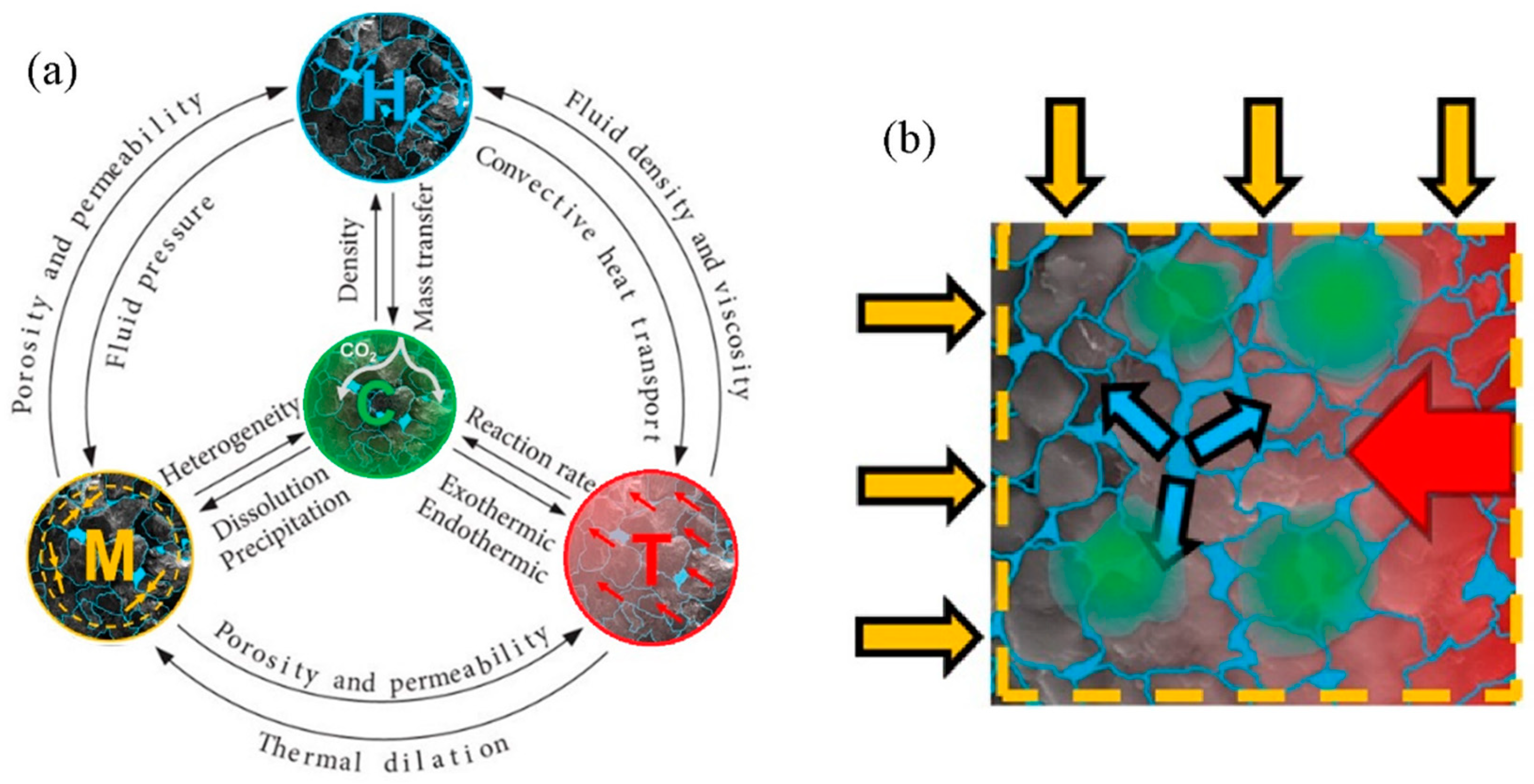
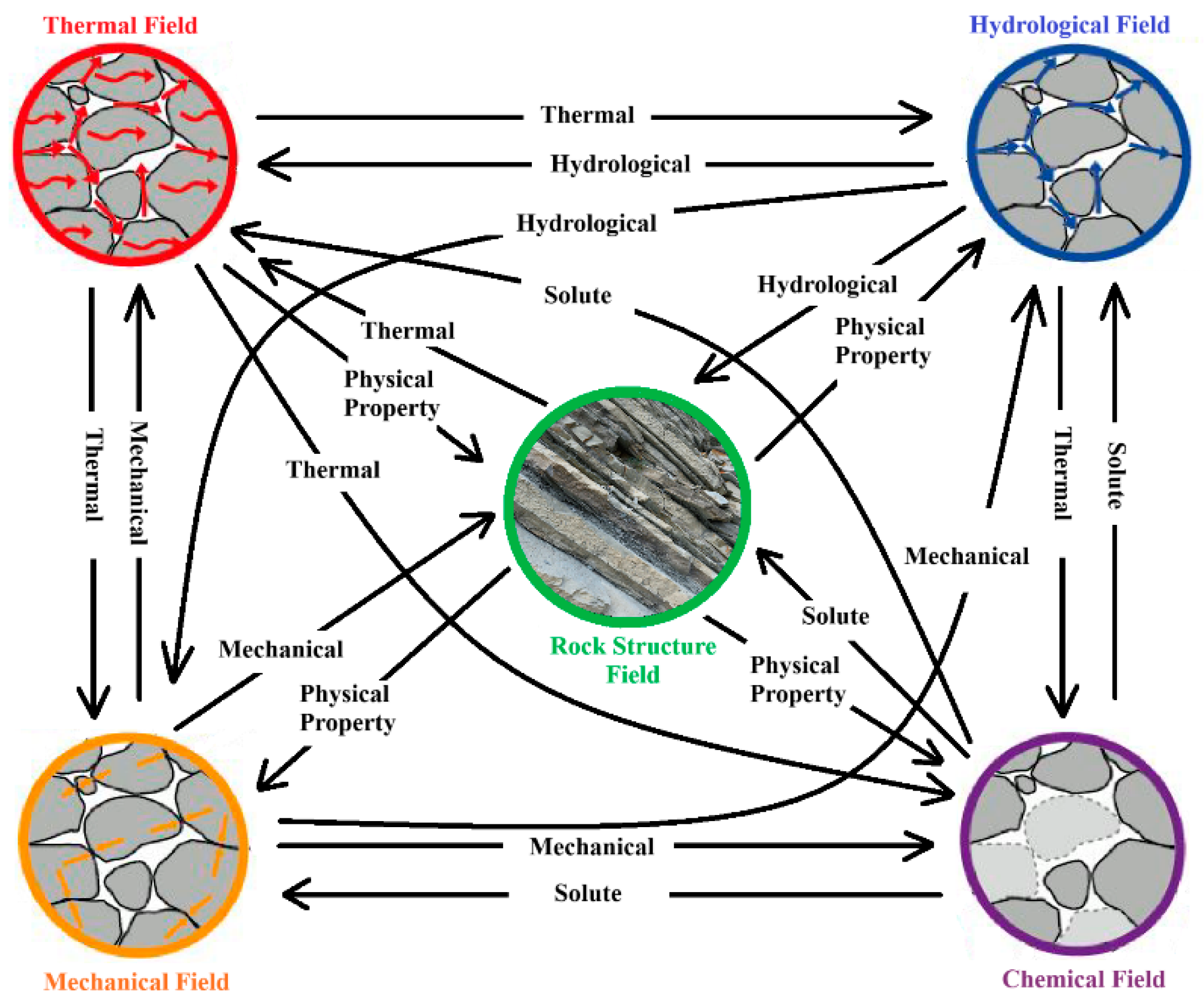
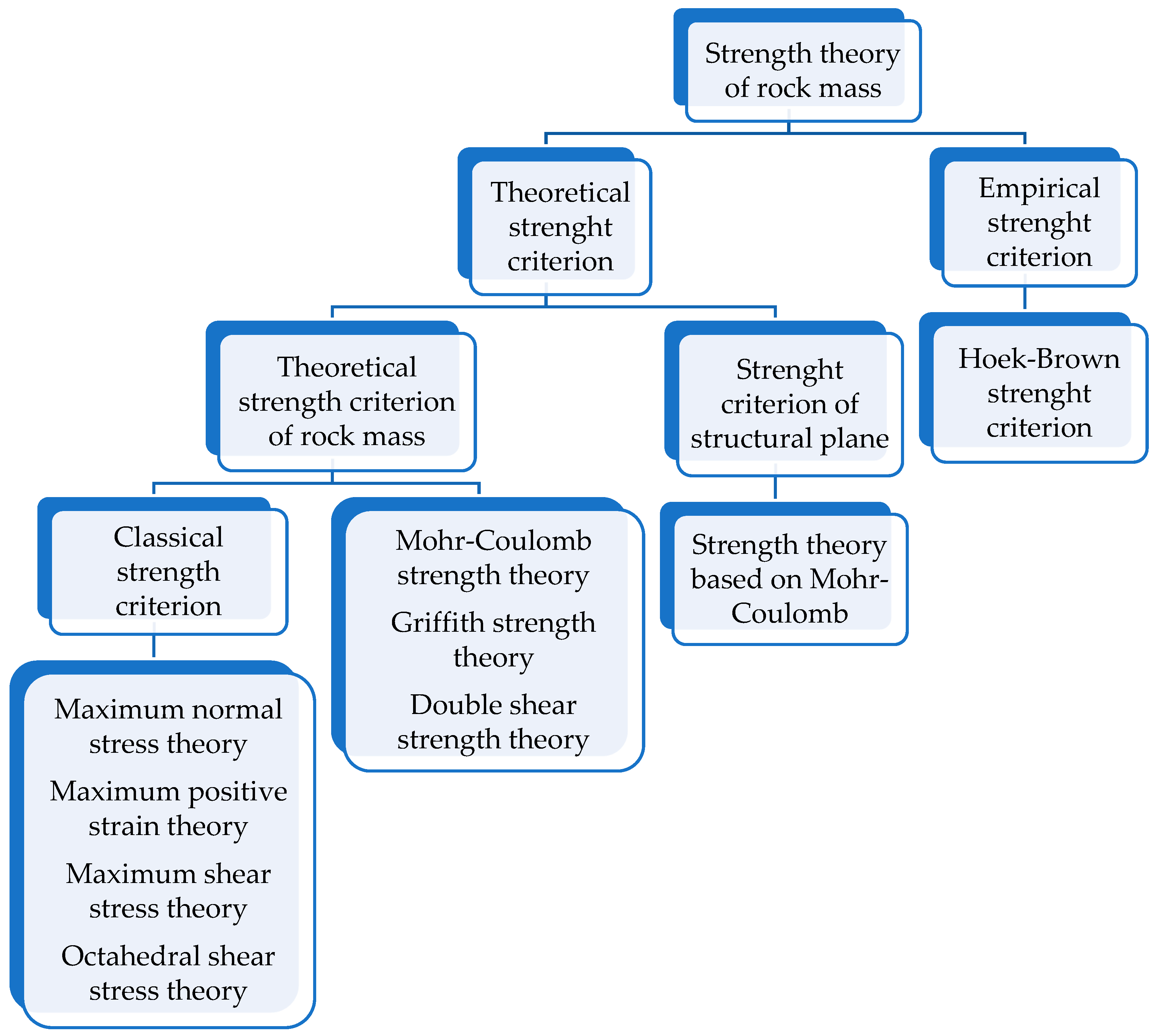
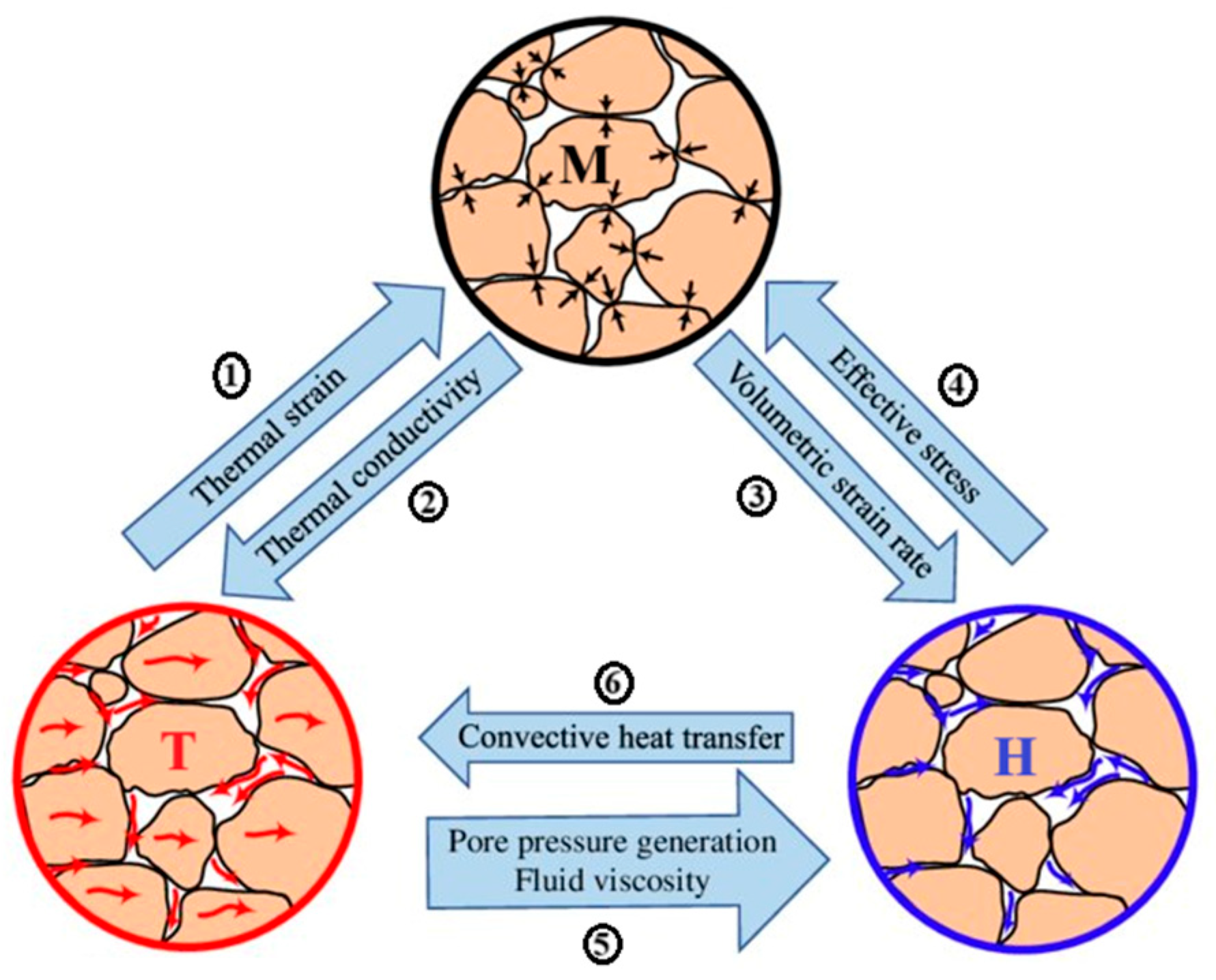
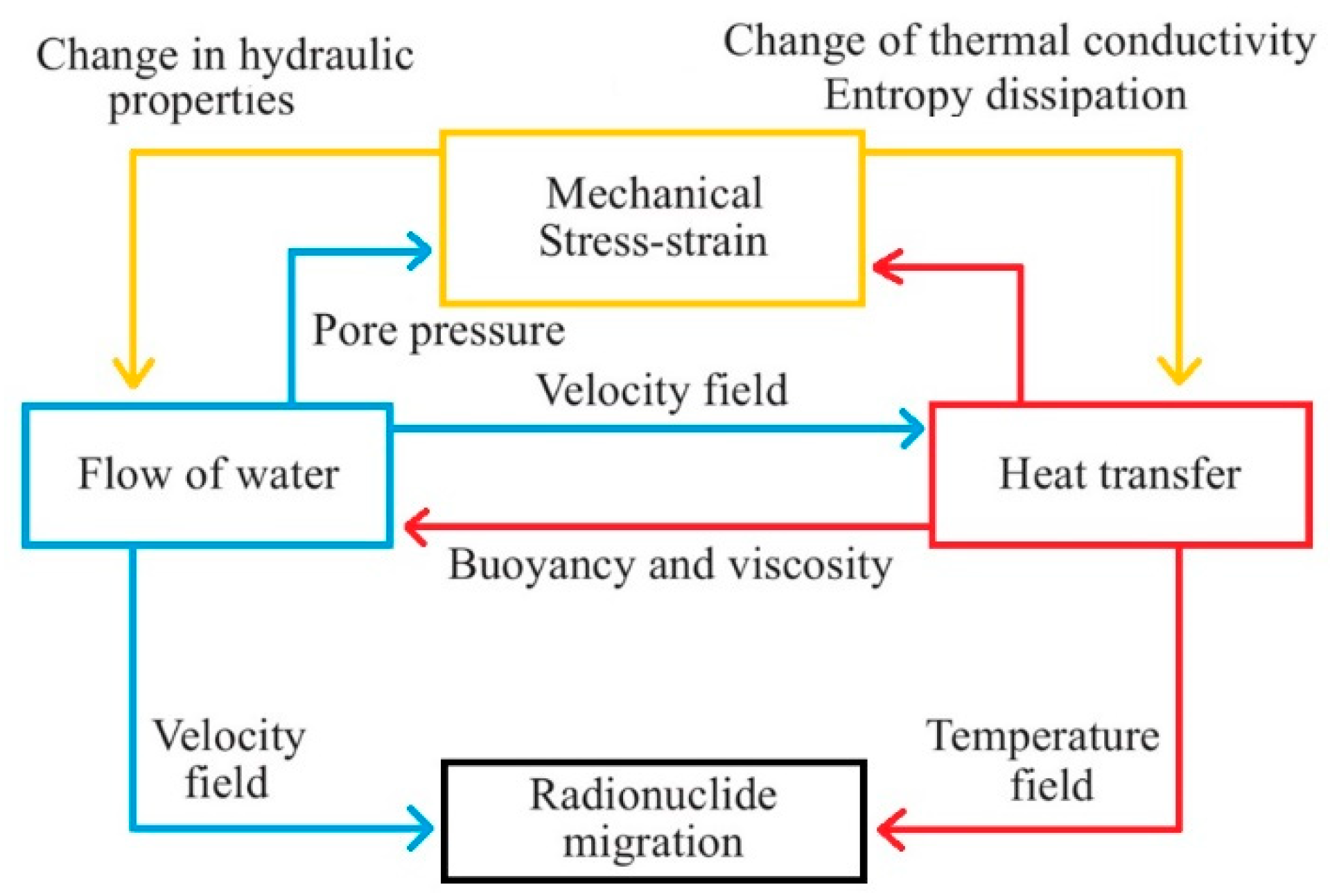
| No. | Reference | Main Content/Mechanical Approach |
|---|---|---|
| 1. | Birkholzer et al. (2022) [2] | The understanding and modeling of THMC coupling processes in geological systems |
| 2. | Hudson et al. (2017) [4] | Coupled THMC modeling for safety assessment of geological disposal of radioactive wastes |
| 3. | Zheng et al. (2017) [14] | Coupled THMC models for bentonite in an argillite repository for nuclear waste: Illitization and its effect on swelling stress under high temperature |
| 4. | Fan et al. (2019) [33] | A THMC coupling model and its application in acid fracturing enhanced coalbed methane-recovery simulation |
| 5. | Yi et al. (2021) [44] | THMC coupling fracture criterion of brittle rock |
| 6. | Pan et al. (2016) [64] | An approach for simulating the THMC process in single novaculite fracture using EPCA |
| 7. | Tsang et al. (2009) [66] | Introductory editorial to the special issue on the DECOVALEX–THMC project |
| 8. | Bernier et al. (2017) [79] | Implications of safety requirements for the treatment of THMC processes in geological disposal systems for radioactive waste |
| 9. | Fan et al. (2019) [80] | THMC couplings controlling CH4 production and CO2 sequestration in enhanced coalbed methane recovery |
| 10. | Tao et al. (2022) [81] | Permeability and porosity in damaged salt interlayers under coupled THMC conditions |
| 11 | Zhang et al. (2015) [82] | Sequentially coupled THMC model for CO2 geological sequestration into a 2D heterogeneous saline aquifer |
| 12. | Yi et al. (2019) [84] | A new measurement method of crack propagation rate for brittle rock under THMC coupling condition |
| 13. | Gan et al. (2021) [94] | The use of supercritical CO2 in deep geothermal reservoirs as a working fluid: insights from coupled THMC modeling |
| 14. | Izadi et al. (2015) [98] | The influence of THMC effects on the evolution of permeability, seismicity, and heat production in geothermal reservoirs |
| 15. | Taron et al. (2009) [100] | Numerical simulation of THMC processes in deformable, fractured porous media |
| 16. | Zheng et al. (2008) [101] | A coupled THMC model of the FEBEX mock-up test |
| 17. | Zheng et al. (2010) [102] | A coupled THMC model of a heating and hydration laboratory experiment in unsaturated, compacted FEBEX bentonite |
| 18. | Xu et al. (2021) [103] | Coupled THMC modeling on acid fracturing in carbonatite geothermal reservoirs containing a heterogeneous fracture |
| 19. | Liu et al. (2015) [104] | Stress evolution in THMC GMZ-bentonite China-Mock-up for geological disposal of high-level radioactive waste in China |
| 20. | Sun et al. (2018) [105] | A coupled THMC model for methane hydrate-bearing sediments using COMSOL Multiphysics |
| 21. | Wu et al. (2017) [106] | A coupled THMC modeling application of cemented coal gangue-fly ash backfill |
| 22. | Yin et al. (2011) [107] | Coupled THMC modeling of CO2 injection by finite element methods |
| 23. | Jing et al. (2003) [108] | Numerical modeling for coupled THMC processes of geological media—International and Chinese experiences |
| 24. | Shao et al. (2008) [109] | THMC coupling in geomaterials and applications |
| 25. | Poulet et al. (2012) [110] | THMC coupling with damage mechanics using ESCRIPTRT and ABAQUS |
| 26. | Andersson et al. (2004) [111] | THMC modeling of rock mass behavior |
| 27. | Alexander et al. (2016) [60] | Development of approaches for modeling coupled THMC processes in single-granite-fracture experiments |
| 28. | Chittenden et al. (2016) [63] | Bounding the uncertainty of key THMC processes during fluid flow in fractured granite |
| 29. | Bond et al. (2016) [112] | Synthesis of coupled THMC modeling of a single novaculite fracture for DECOVALEX-2015 |
| 30. | McDermott et al. (2015) [62] | Application of hybrid numerical and analytical solutions for the simulation of coupled THMC processes during fluid flow through a fractured rock |
| 31. | Yasuhara et al. (2011) [113] | Temporal alteration of fracture permeability in granite under hydrothermal conditions and its interpretation by coupled chemo-mechanical model |
| 32. | Yan et al. (2020) [114] | A review of the research on physical and mechanical properties and constitutive model of rock under THMC multi-field coupling |
| 33. | Kolditz et al. (2016) [115] | THMC processes in fractured porous media |
| 34. | Bond et al. (2014b) [116] | Coupled THMC modeling of a single fracture in novaculite for DECOVALEX-2015 |
| 35. | Xu et al. (2016) [117] | Coupled THMC modeling on chemical stimulation in fractured geothermal reservoirs |
| 36. | Zhou et al. (2024) [118] | A granular thermodynamic constitutive model considering THMC coupling effect for hydrate-bearing sediment |
| 37. | Yoon et al. (2016) [119] | Assessment of THMC performances of Ca-type bentonite–graphite mixtures as buffer materials for a high-level radioactive waste repository |
| 38. | Mortazavi et al. (2016) [120] | Coupled THMC simulation of silicate rocks with an enriched-FEM model |
| 39. | Song et al. (2024) [121] | Fully coupled THM constitutive model for clay rocks |
Disclaimer/Publisher’s Note: The statements, opinions and data contained in all publications are solely those of the individual author(s) and contributor(s) and not of MDPI and/or the editor(s). MDPI and/or the editor(s) disclaim responsibility for any injury to people or property resulting from any ideas, methods, instructions or products referred to in the content. |
© 2025 by the authors. Licensee MDPI, Basel, Switzerland. This article is an open access article distributed under the terms and conditions of the Creative Commons Attribution (CC BY) license (https://creativecommons.org/licenses/by/4.0/).
Share and Cite
Wang, J.; Ahmed, B.; Huang, J.; Nong, X.; Xiao, R.; Abbasi, N.S.; Alidekyi, S.N.; Li, H. Physical and Mechanical Properties and Constitutive Model of Rock Mass Under THMC Coupling: A Comprehensive Review. Appl. Sci. 2025, 15, 2230. https://doi.org/10.3390/app15042230
Wang J, Ahmed B, Huang J, Nong X, Xiao R, Abbasi NS, Alidekyi SN, Li H. Physical and Mechanical Properties and Constitutive Model of Rock Mass Under THMC Coupling: A Comprehensive Review. Applied Sciences. 2025; 15(4):2230. https://doi.org/10.3390/app15042230
Chicago/Turabian StyleWang, Jianxiu, Bilal Ahmed, Jian Huang, Xingzhong Nong, Rui Xiao, Naveed Sarwar Abbasi, Sharif Nyanzi Alidekyi, and Huboqiang Li. 2025. "Physical and Mechanical Properties and Constitutive Model of Rock Mass Under THMC Coupling: A Comprehensive Review" Applied Sciences 15, no. 4: 2230. https://doi.org/10.3390/app15042230
APA StyleWang, J., Ahmed, B., Huang, J., Nong, X., Xiao, R., Abbasi, N. S., Alidekyi, S. N., & Li, H. (2025). Physical and Mechanical Properties and Constitutive Model of Rock Mass Under THMC Coupling: A Comprehensive Review. Applied Sciences, 15(4), 2230. https://doi.org/10.3390/app15042230







